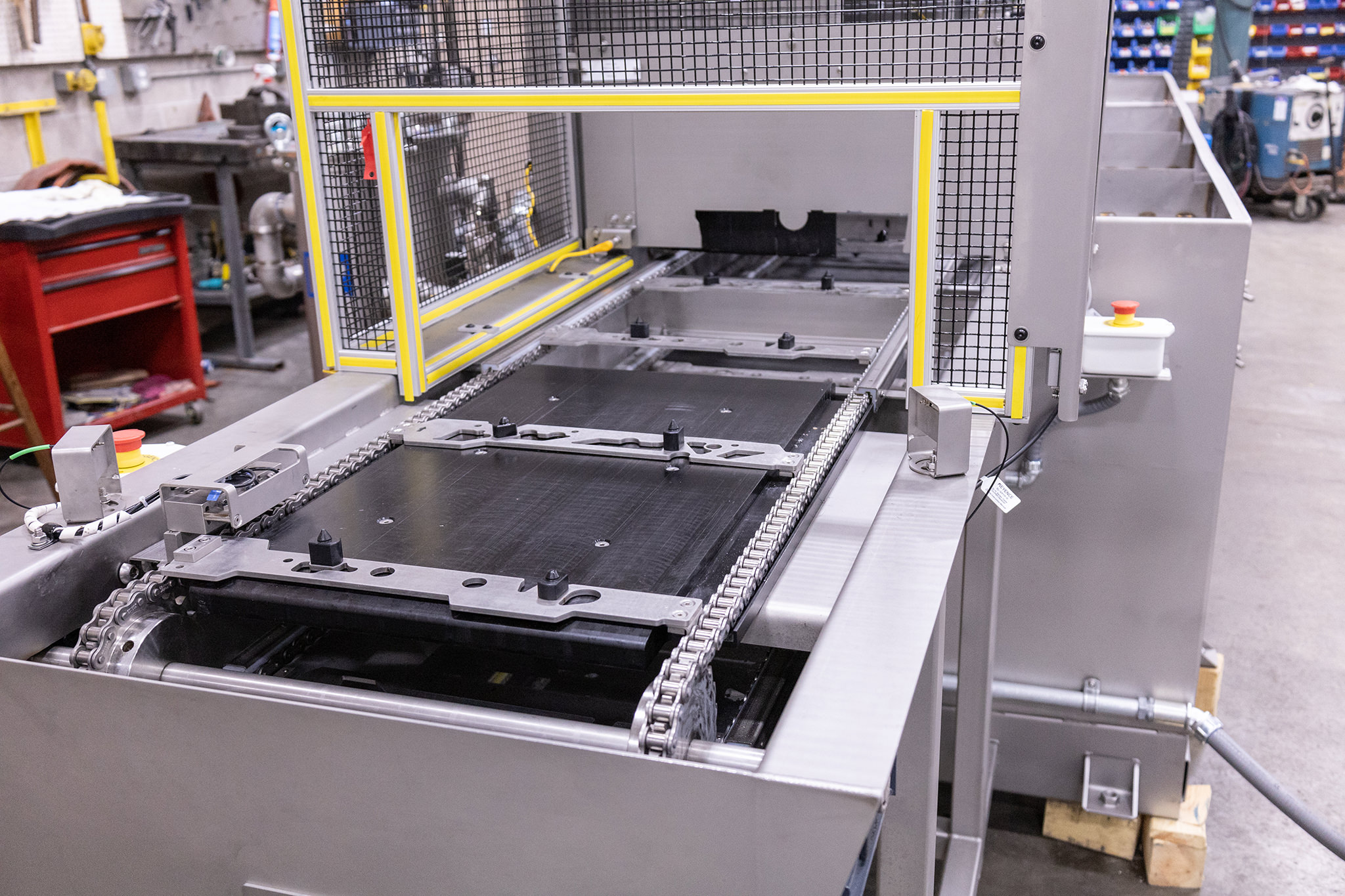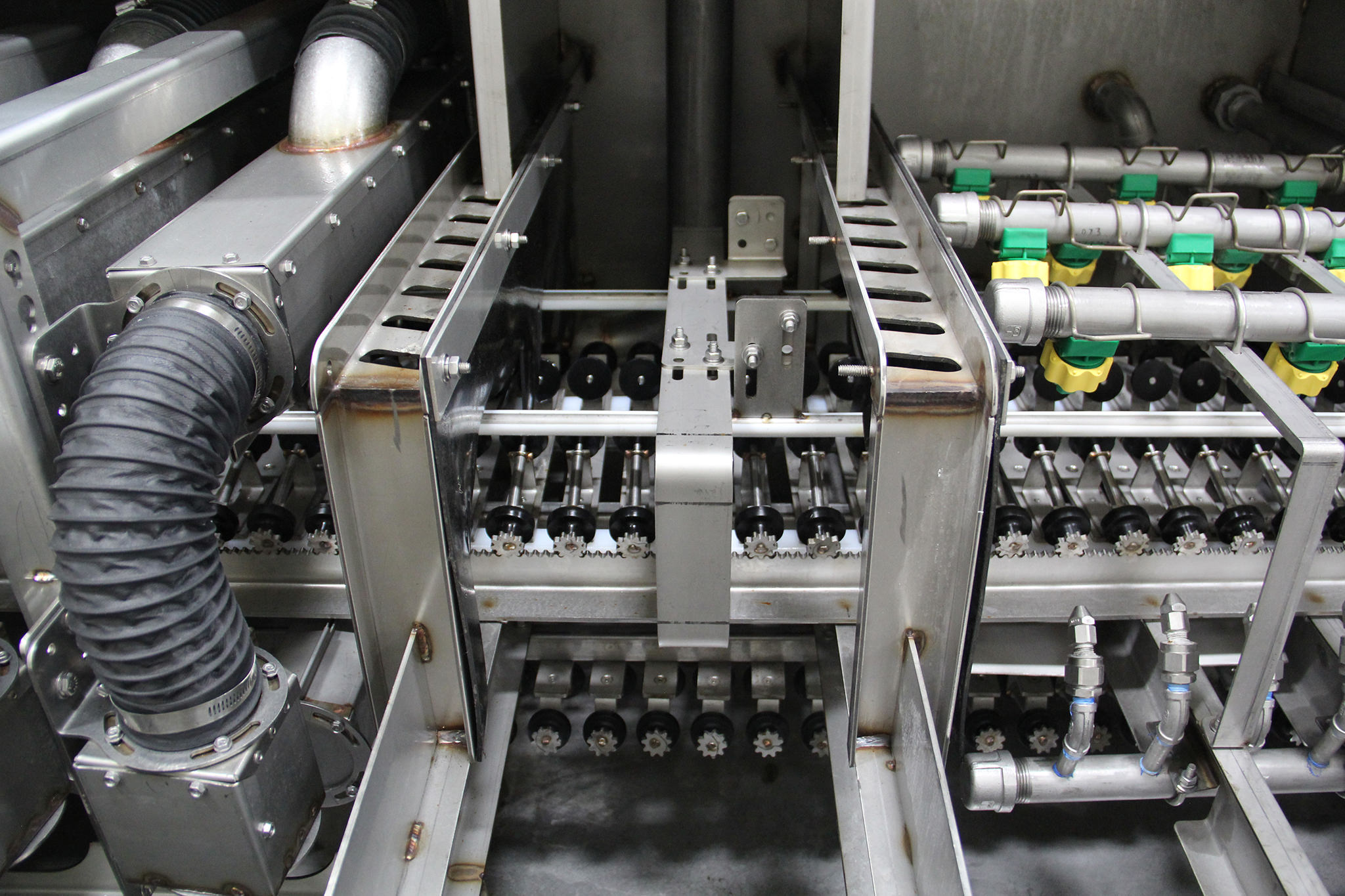
Conveyor parts washers are best known for their versatility and primarily designed for in-line cleaning at high volume production rates, for parts ranging from small to large in size. Due to their efficiency, cost effectiveness, available options and range of configurations, conveyor parts washers can be found in industrial cleaning operations across a multitude of industries, and have become a popular piece of equipment for effectively cleaning parts.
In fact, a study found that conveyor parts washing machines can perform two days’ worth of manually cleaning parts by hand to about three hours.
Conveyor Parts Washers Role in Removing Contaminants
Conveyor parts washers are used to clean, degrease, and dry many small or big parts in preparation for surface treatment, assembly, inspection, or export. Recently machined, forged, or manufactured parts are covered in chemicals, grease, cutting fluids, oils, abrasive dust, debris, paint, and fabrication-related residue. Therefore, a part must be cleaned before it can be coated or added to the subsequent assembly.
Conveyor parts washers use various cleaning mediums to eliminate impurities. Components washers effectively remove debris by using a variety of solvents, chemicals, or alkaline cleaning agents.
What is a Conveyor Part Washer?
Conveyor parts washers are high volume parts washing systems that are designed to handle parts ranging in size from very small non-precision parts and components, to manufactured products that are very large and intricate. They’re ideal for cleaning parts automatically in a continuous process. The key to these technically-advanced washing systems is the effectiveness of the cleaning provided and the volume of parts processed.
An important aspect of conveyor parts washers is their ability to match the cleaning requirements of any part design. Although conveyor parts washers normally have multiple zones, they can be customized to have one, two, or more cycles depending on the types of cleaning required. This includes wash, rinse, deionized or freshwater rinse, ambient blow-off, and heated blow-off.

Conveyor parts washing systems can utilize any type of automated transport system that moves parts or products through each phase of the cleaning and drying process. The conveyor method differs depending on the functions of each cleaning stage.
The following are common types of conveyors used in part cleaning systems:
- Mesh conveyor belt: Constructed of stainless steel and other corrosion-resistant materials, parts are placed directly on the conveyor belt, and 360-degree spray covers the parts for thorough cleaning. The stainless-steel open wire mesh belt allows for optimal cleaning from top, sides and bottom of the conveyor. Multiple belt materials and types are available for specific applications to ensure that your parts stay free of contaminants. Belt speed is also adjustable.
- Monorail conveyor: In a monorail conveyor system, manufactured parts are transported through the parts cleaning system by way of an overhead monorail conveyor. Hangers are designed to hold parts without scratching the component’s surface, ensuring a firm fit and uniform travel through the parts washer as they progress through each process zone. This can be an internally mounted monorail system or externally mounted monorail system.
- Dual chain conveyor: Dual chain conveyor systems are designed to hold specialized part fixtures attached directly to the chain, or to hold part pallets that allow parts to be shuttled to various workstations in the manufacturing facility. Chain conveyor systems can easily be integrated with other conveying and transfer systems.
- Rotary drum: A rotary drum parts washer is an automatic parts washer that contains a perforated rotating drum in which parts are placed for continual cleaning. It’s ideal for cleaning small, non-precision parts. The perforated drum allows fluid to drain quickly while internal flights and kicker bars move parts through the system using a gentle tumbling action.
- Indexing system: These specialized conveying systems use a programmed start-stop servo drive system to move parts to each zone. Parts are held in place using specialized part fixtures, and sensors ensure that the parts are in position. Indexing systems are designed for applications which require critical cleaning of parts with specific features such as blind holes, passageways, hidden cavities, and sensitive surfaces. Indexing parts cleaning systems are intended for use in high-volume manufacturing cells and production lines. Indexing parts washers can be operated manually or coupled with robotics load/unload automation systems. To learn more about using indexing in cleaning applications, click here.
Need help determining which system is best for your needs? Contact us to speak to one of our experienced engineers about your application needs.
How Conveyor Parts Washing Systems Work
Conveyor parts washing systems are designed for a continuous flow of parts for cleaning. The process of an automated parts washing system is exceptionally efficient and effective. Contaminants are removed such that the cleaned parts can be moved on to the next manufacturing process.
Conveyor parts washers have been enhanced and improved as technology, and new efficiency techniques have also advanced. Even while manual parts cleaning is still frequently used, for the most part, it has been automated or semi-automated to increase productivity.
How to Determine the Size of a Conveyor Parts Washing System
Manufacturing processes are custom-designed to fit the needs of a process, operation, or application. Careful consideration is given to every element and component such that the various aspects of a system smoothly and efficiently integrate for maximum performance. Parts washing equipment needs to be sized to properly fit into a well-designed system and meet the level of cleanliness required by providing the most cost-effective process available. To read more about how to size a parts washer click here.
To decide which parts washer design should be used, the customer must submit five essential pieces of information: The part profile, manufacturing rate, contamination to be eliminated, required cleanliness, and required dryness are the first five factors. The parts washer design and overall size can be decided once this information has been gathered. The following are design considerations for the determination of the size of the conveyor part washer:
- Part profile: The part size, design complexity, and material must all be considered while determining the washer’s design and size.
- Contamination to be removed: The kind of contamination on the part will affect how long it takes to clean.
- Production rate: The quantity of components cleaned in a specific time is known as the production rate, also known as the cycle time.
- Cleanliness requirement: Some parts may only need to be visually clean, while others must adhere to a strict cleanliness specification expressed in terms of total mass, particle size, quantity, or a combination of all three.
- Dryness requirement: An ambient blow-off module may be adequate for the drying process if there is some acceptable residual moisture on the items as they exit the washer, but some applications may require parts be 100% dry, in which case a heated blow-off blower should be used.
The combination of these factors provide an indication of the model of parts washer that will best suit the needs of a cleaning process. In the case of conveyor parts washing systems, production rate is a key factor since most conveyor parts washer systems are designed for high-volume washing and drying.
Leader in Conveyor Parts Washers Systems
Alliance Manufacturing, Inc. is a leader in the parts washer industry. With years of experience, and a multitude of custom options available for parts washer design, Alliance can meet even the strictest cleaning requirements.
For more information or for help determining which parts washer is best for your application, contact us to discuss your project with one of our experienced engineers.